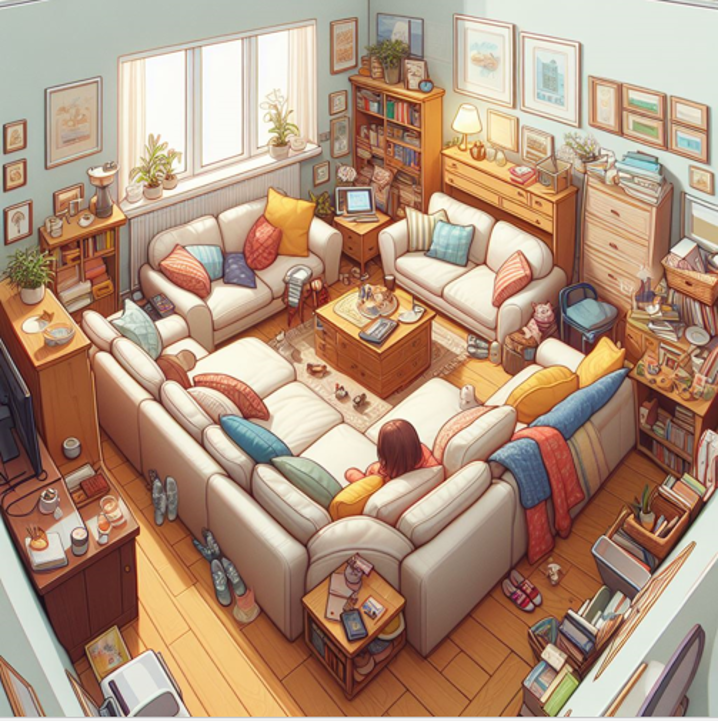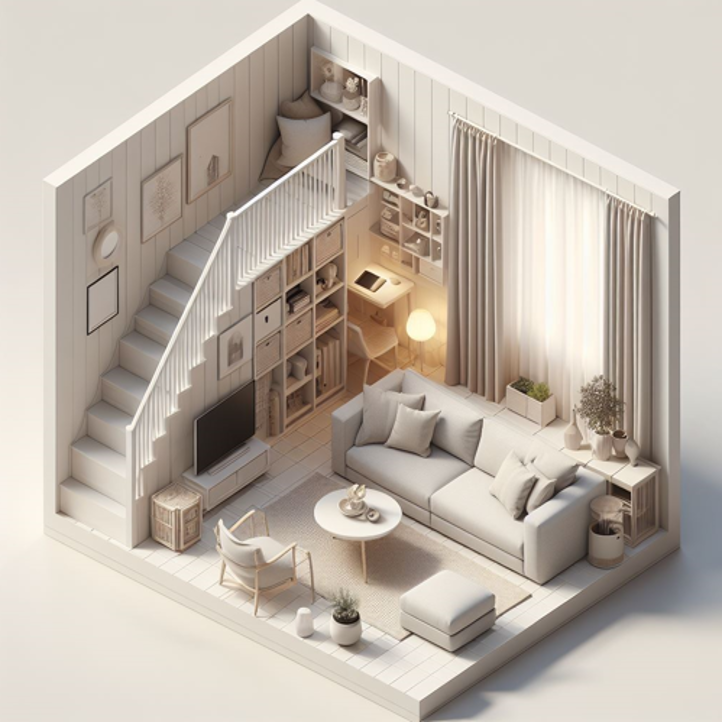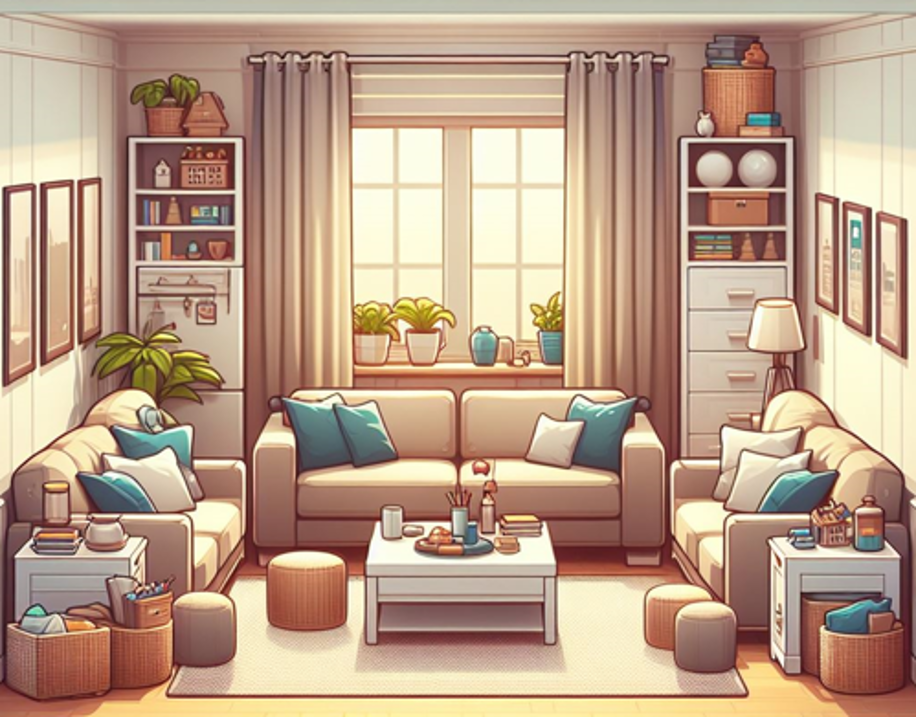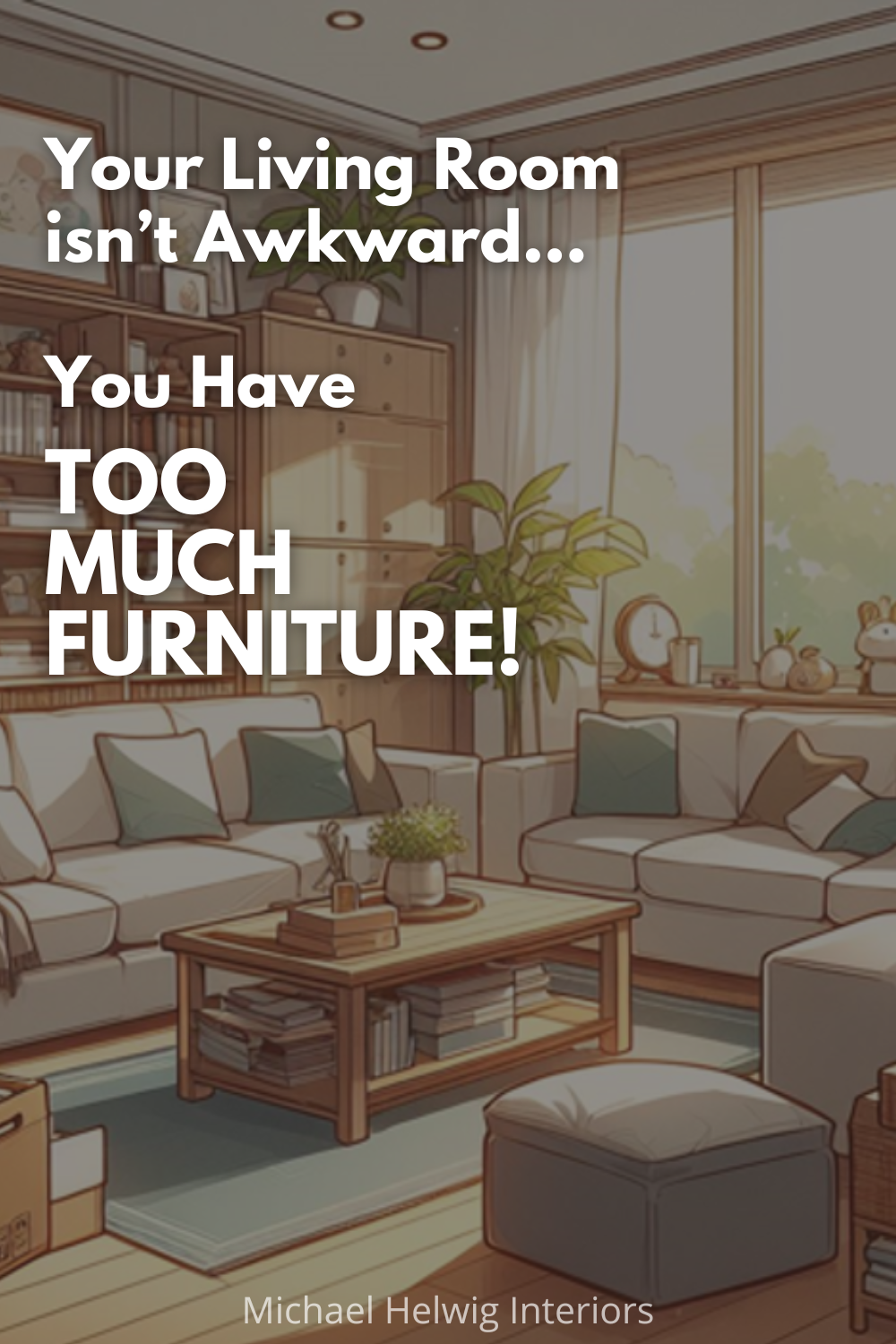The feeling of awkwardness in a cluttered living room can be suffocating.
It's not just about aesthetics; it's about how your space makes you feel.
If every time you walk into the room, you're met with a barrage of obstacles – chairs that block pathways, tables piled high with clutter, and shelves overflowing with knick-knacks, it can make you want to run for the hills.
This unease isn't just in your head. Studies have shown that living in a cluttered environment can increase stress levels, affect mental clarity, and even disrupt sleep patterns. In other words, your cluttered living room might be more than just an eyesore – it could be negatively affecting your quality of life.
So, what’s the solution? You guessed it, declutter your rooms!
Now, I’ve blogged about the benefits of decluttering stuff in many other posts. When you remove the excess papers, décor, unused things, etc., your home becomes so much more enjoyable to be in.
This one is a bit different. This is all about how having too much furniture and/or furniture that doesn’t fit- physically- in your rooms, and how that can make you want to avoid the rooms completely.
I got the idea for this article from a few conversations with past clients.
It came about because I recalled a handful of them telling me that they disliked their crowded rooms so much that they avoided being in them completely. When you live in a smaller home, not using an entire room seriously limits the functionality of your entire house.
It’s not a stretch to say that their other rooms had to pick up the slack of the rooms that they didn’t want to be in.
One client’s master bedroom became the hangout space for her teenage daughter and her daughter’s friends. Their living room was packed with too much furniture that getting into the room and onto the sofa required the skills of an acrobat.
So, mom said, “just go hang out in my room instead.” Soon, late night movies and sleepovers kept mom downstairs in the kitchen even when she wanted to go to bed. No thanks!
Another client avoided her bedroom and slept in the living room on the sofa for YEARS because her bedroom felt overloaded with furniture and not restful.
So, she had bed pillows, blankets, and a dresser full of clothes in the living room just so she didn’t have to go near her bedroom. (The dresser was also too big and clunky for the living room, which limited the living room’s functionality, more on that in a minute...)
And another client hired me to help them figure out the best layout for furniture in their dining room. When I asked how often they used the dining room, she told me never.
The room was too small for the furniture they had, so they used the table as a catch all drop spot instead of for family meals. She avoided hosting holidays and birthdays because the dining room was so unwelcoming, until the excuses for not hosting at their house started to cause a rift with her siblings - who were stuck hosting all the time. Awkward…
The common theme for each was they didn’t know how much their overcrowded rooms were affecting their lives. They just thought that it was something they had to live with instead of change. The truth is, there’s always a solution for tricky, awkward, or small rooms. And I’ll let you in on a secret – Many times the way a room feels can be changed completely by the right size and amount of furniture in it.
Today I’d like to talk about how you can know for sure if you have issues with furniture affecting your space, how to get better flow, and selecting multi-functional pieces that maximize both style and function to maximize the functionality of your rooms. (That’s a lot but I’ll make my advice as short and to the point as I can.)
So, if you're tired of feeling cramped and uncomfortable in your own home, read on to find out how to transform your living room into a place you'll love spending time in.
The Art of Furniture Consolidation
The first place to take a get a handle on making a more comfortable living room is to look at what furniture can be consolidated.
This is looking at your room strategically in terms of reevaluating and reorganizing the room’s layout for better flow and function.
Consolidating furniture is about thoughtfully assessing each piece in the room, considering its purpose, placement, and potential for multi-functionality. By streamlining your furniture this way and optimizing its arrangement, you’ll create a more harmonious and inviting space that’s better for movement, conversation, and relaxation.
Consolidating furniture isn't just about getting rid of unnecessary pieces; it's about creating a curated look that serves both aesthetic and practical purposes.
It's about finding the right balance between form and function, style, and substance.
Whether you're dealing with a small living room or a massive family room, consolidating your furniture can change the look and feel of it immediately. You’ll begin to see how it can go from cluttered and uncomfortable to serene.
The Nuts and Bolts of Furniture Consolidation
6 Ways to Tell if You Have Too Much Furniture: Signs of overcrowding.
Limited Pathways: One of the most evident signs of having too much living room furniture is narrow pathways or cramped walkways. If you find yourself having to navigate through a maze of chairs, tables, and other stuff just to move from one end of the room to the other, it's clear that your room is overcrowded.
2. Visual Clutter: Take a moment to step back and observe your living room from a distance. Does it look cluttered and chaotic, with furniture pieces competing for attention? Are your surfaces covered with too many tohotchkes, books, and knick-knacks? Visual clutter can overwhelm the eye and create a sense of busyness that detracts from the room.
3. Lack of Breathing Room: Another telltale sign of overcrowding is the absence of negative space – areas of open floor or wall space that provide visual relief and allow the room to "breathe." If every inch of your living room is taken up by furniture or decor, leaving little room for movement or relaxation, you have too much furniture.
4. Difficulty Functioning: Consider how easy or difficult it is to do everyday things in your living room. Do you struggle to find a comfortable seat because of too many chairs and sofas? Is it challenging to set down a drink or book because every surface is cluttered with stuff? If the process of “living” in your living room is difficult, it’s probably overcrowded.
5. Circulation: how do people move through the room? Are there clear pathways that allow easy movement from one area to another, or do you find yourself constantly weaving around furniture to get from point A to point B? Pay attention to any bottlenecks or areas where traffic flow is obstructed.
6. General Discomfort: Ultimately, the most significant sign of having too much furniture is a feeling of discomfort or unease when you spend time in the room. If you find yourself constantly bumping into furniture, feeling overwhelmed by the visual clutter, or unable to relax and enjoy the space, changes need to be made.
After you’ve figured out what’s causing your room to feel overcrowded, it’s time to take some action toward creating a more spacious and inviting living room.
Assessing Your Room’s Flow and Functionality
Functional Zones: Consider the various activities that take place in your living room, like lounging, entertaining, and working. Does your furniture layout support each of these activities, or does it feel haphazard and disjointed? Think about if the current layout supports the functional needs of the space and whether there are different ways to tweak the arrangement for better efficiency.
Sightlines: Sit in different areas of the room and observe your line of sight. Are there obstructions that block views or create visual barriers between different areas of the room? How can you change things for clear sightlines, a sense of openness, and connectivity in the room?
Accessibility: Consider the accessibility of key furniture pieces and amenities in the room. Are things hard to reach or use due to their placement or proximity to other furniture? Consider if the current arrangement makes it easy for everyone in the house to be comfortable.
Flexibility: Can the furniture be easily rearranged to create more space for entertaining or to accommodate larger gatherings? In other words, can the current layout be versatile and flexible for different activities easily?
By carefully thinking about the flow and functionality of your living room, you’ll quickly tell how well the space is serving your needs and where improvements can be made.
Now, let’s focus on how to enhance your living room’s flow and function by optimizing your furniture arrangement.
Identifying unnecessary or redundant pieces
Duplicate Functions: Look at your furniture and figure out which pieces serve duplicate functions or overlap in their purpose. For example, do you have too many accent tables scattered throughout the room? Are there chairs or sofas that don’t get used because there are too many other ones? Ask yourself, are these duplicate pieces necessary? Can they be consolidated or repurposed to serve the space better?
Underutilized Items: Determine which pieces are used often and which ones go untouched. Are there pieces that take up space without adding value to the room? Consider whether these underutilized items can be removed or replaced with more functional pieces that better suit your needs.
Scale and Proportion: Look at your furniture in relation to the size and layout of the room. Are there pieces that overpower the space or appear too large or too small? If so, downsizing or replacing these pieces with appropriately scaled alternatives could help create a more balanced and harmonious layout.
Visual Clutter: Look for furniture pieces that add to visual clutter or create a sense of overcrowding in the room. Are there bulky or oversized pieces that dominate the space and take away from its overall aesthetic? If the answer is yes, simplify the room by eliminating those unnecessary pieces to create a cleaner, more streamlined look.
Personal Preferences: This is the “trust your gut” part of enhancing your space. Think about your own personal preferences to figure out which pieces can be removed or consolidated. Are there items that no longer make sense with your tastes or functional needs? Keep your end goal of having a more functional and comfortable room and plan to remove these pieces. They can be repurposed, donated, or sold to make room for new things that better reflect your lifestyle.
Removing redundant furniture can streamline your living room layout and create a more functional and comfortable living room.
Creating Zones Within the Living Room
I know I touched on zones above, but I think that defining functional zones in any room that might have multiple purposes is so important. So, I want to expand a little more as to what functional zones are and how best to use them.
1.Define Functional Areas: Start by identifying the different activities that take place in your living room, like lounging, entertaining, dining, and working. Then, create different zones in the room to accommodate each of these activities. For example, designate one area for seating and conversation, another for dining or eating, and a third for work or study. Even if your room is small, there’s always room to zone for better function.
2. Think About Traffic Flow: How do people will move through the space? Are there clear pathways between each zone so it’s easy to move? Avoid placing furniture or other obstacles in high-traffic pathways to prevent congestion. If a piece you place feels like is hindering the room’s openness and connectivity, find a better choice.
3. Use Furniture Placement: Furniture placement should enhance and define each zone in your living room. For example, place sofas, chairs, and the coffee table to create seating areas for conversation and relaxation. Use rugs to define areas like main seating, dining, office, etc. Then lighting, and other accessories to further enhance each zone, creating visual cues that signal the purpose of each area.
4. Maximize Functionality: Make sure that each zone is equipped with the necessary pieces to support its intended function. For example, seating areas should have comfortable seating options and side tables for drinks and snacks. Likewise, adequate lighting, storage, and a work surface is important for a ‘work/office’ area in a living room.
5. Balance Aesthetics and Practicality: Choose furniture and decor that not only looks good but also adds to the functionality of each zone. Again, think about the scale, proportion, and visual impact of each piece, so that they complement the overall design and purpose(s) of the room.
Whether you're entertaining guests, enjoying a quiet evening at home, or tackling work projects, having well-defined zones within your living room can help you make the most of your space and create a comfortable and inviting space.
Choosing Multifunctional Furniture Pieces
Now that you know why your living room feels uncomfortable, and you’ve consolidated furniture, and figured out how you want your room to function, it’s time to think about pieces that will help you keep the new aesthetic in your room. Whether to have a large room, or a small room, multi-functional pieces will help you maintain all the hard work you did to makeover your room.
Sofa Beds or Sleeper Sofas: Think about getting a sofa bed or sleeper sofa that’s both seating during the day and a comfortable sleeping space for guests at night. Versatile pieces are ideal for small living rooms or multi-purpose spaces where maximizing functionality is key. Look for sofa beds with easy-to-operate mechanisms and high-quality mattresses for better comfort.
2. Modular Furniture: These allow you to customize and reconfigure your living room layout to suit your changing needs. Look for modular sofas, shelving units, and storage cabinets that can be easily rearranged and expanded as needed. These flexible pieces offer endless possibilities for creating unique and functional living room setups that can adapt to your lifestyle.
3. Convertible Dining Tables: A table like this is a practical solution for small living spaces that lack a dedicated dining room. Many times these tables have drop down table leaves or removable table leaves so they can be extended or transformed to accommodate larger gatherings or folded down to save space when not in use. Look for models with built-in storage compartments or adjustable height settings for added versatility.
4. Nesting Tables or Stacking Chairs: You’ll save space in your living room by choosing nesting tables or stacking chairs that can be tucked away or stacked when not in use. Nesting tables typically feature multiple tables of varying sizes that can be stacked together for compact storage, while stacking chairs can be stacked vertically to save floor space. Nesting tables are a favorite of mine when designing small, awkward, or tricky rooms where full-size end tables are not an option. I like round ones because they fit nicely in corners or in pathways where a temporary table is needed.
5. Cube Ottomans with Storage: Not only do they provide extra seating or a place to prop up your feet, but they also have storage compartments inside. These storage ottomans usually have removable lids that conceal space for stowing away blankets, pillows, magazines, or other items you want to keep out of sight.
6. Drink Tables: I love a small drink table and I often place them along size swivel chairs, especially when the chairs are floating in a seating arrangement. Much like nesting tables, small drink tables can be stored away in a corner when not in use or used as a small plant stand for everyday purposes. I prefer round ones next to swivel chairs because there are no corners for the chair to catch as it moves.
To Conclude:
There are many ways to reimagine a tricky or awkward living room. All you have to do is assess what isn’t working, make a plan for EXACTLY how you want it function through zones, and incorporate the pieces that will fit and possibly offer multiple functions, you’ll have a living room that’s inviting and comfortable for many years.
Remember, if your living room feels awkward, it may just be overwhelmed with too much furniture.
Try these tips out for yourself and let me know in the comments below how you make out?
Read Next:
Beyond Aesthetics: The Science Behind Comfortable And Cozy Homes
Ready to cozy up and unlock the secrets of ultimate home comfort? 🛋️✨ Dive into the science of feeling good at home—beyond just fluffy blankets and candles. Discover how your space affects your mood, stress levels, and overall well-being. Get comfy and click to find out why your home is more than just a place—it's your ultimate sanctuary!
Join the Fun!
If you enjoyed this post and you want to keep seeing my weekly blog, the best way to do that is to subscribe.
You can subscribe by downloading my 11 Secrets Only Designers Know to Make Your Space Rock. If you’re curious about how decorators and designers make a home look magazine ready, you’ll love taking a gander at these 11 secrets. You’ll learn how to style your room from the floor up and it will work for ANY space you have.
I write about small space design and decorating, sustainable furniture options, positive self care and a variety of do-it-yourself home décor.
I’d love to connect with you!
“Michael Helwig was top-notch, very professional and responsive to my needs. He allowed me time to explore ideas and try out a variety of combinations until we found the perfect fit. Michael provided detailed information and offered beautiful ideas to make my dream living room become a reality. The furniture he sourced has totally transformed my living room space. Everyone that has seen my new living room has one word, WOW! A special thank you to Michael for a wonderful experience.”
“Michael was very knowledgeable and guided us, with great patience and good humor, through the process of designing our dining room and helping us find the perfect sleeper sofa. He offered really helpful advice when we asked questions - which was often - but at no time did we ever feel pushed. He helped me when I felt like I couldn’t make one more decision. When my new furniture finally arrived I realized everything down to the pillows was perfect. I couldn’t be happier!”
Michael is Principal designer and blogger at Michael Helwig Interiors in beautiful Buffalo, New York. Since 2011, he’s a space planning expert, offering online interior e-design services for folks living in small homes, or for those with awkward and tricky layouts. He’s a frequent expert contributor to many National media publications and news outlets on topics related to decorating, interior design, diy projects, and more. Michael happily shares his experience to help folks avoid expensive mistakes and decorating disappointments. You can follow him on Pinterest, Instagram and Facebook @interiorsmh.



















